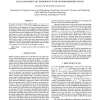Free Online Productivity Tools
i2Speak
i2Symbol
i2OCR
iTex2Img
iWeb2Print
iWeb2Shot
i2Type
iPdf2Split
iPdf2Merge
i2Bopomofo
i2Arabic
i2Style
i2Image
i2PDF
iLatex2Rtf
Sci2ools
ICIP
2006
IEEE
2006
IEEE
Local Discriminant Embedding with Tensor Representation
We present a subspace learning method, called Local Discriminant Embedding with Tensor representation (LDET), that addresses simultaneously the generalization and data representation problems in subspace learning. LDET learns multiple interrelated subspaces for obtaining a lower-dimensional embedding by incorporating both class label information and neighborhood information. By encoding each object as a second- or higher-order tensor, LDET can capture higher-order structures in the data without requiring a large sample size. Extensive empirical studies have been performed to compare LDET with a second- or third-order tensor representation and the original LDE on their face recognition performance. Not only does LDET have a lower computational complexity than LDE, but LDET is also superior to LDE in terms of its recognition accuracy.
Data Representation Problems | ICIP 2006 | Image Processing | Multiple Interrelated Subspaces | Original Lde | Subspace Learning Method | Third-order Tensor Representation |
| Added | 22 Oct 2009 |
| Updated | 22 Oct 2009 |
| Type | Conference |
| Year | 2006 |
| Where | ICIP |
| Authors | Jian Xia, Dit-Yan Yeung, Guang Dai |
Comments (0)

